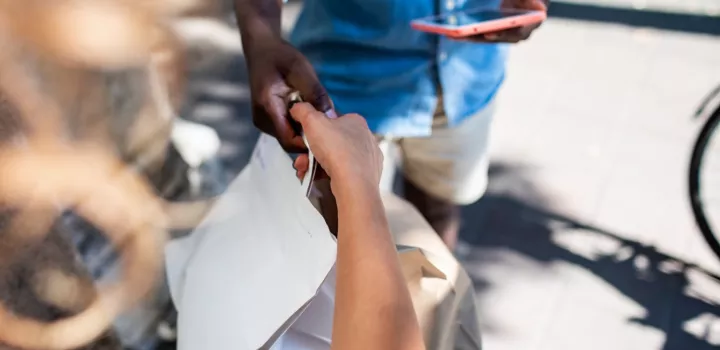
Which Delivery Platform is Best For Your Restaurant?
Journalist Kristen Hawley shares business tips.
Delivery became a must for restaurants during the pandemic, but which delivery platform is right for your business with so many options? Restaurant industry expert Kristen Hawley talks through the many technology partners in the market and what they offer.
If the pandemic taught us anything about the restaurant business it’s that delivery is a critical revenue stream.
Kristen Hawley, journalist and founder of weekly restaurant technology newsletter Expedite, said food delivery strategy is baked into business plans at a recent virtual event for ICE students. “It is something that operators and investors in restaurants want to see, given what’s happened in the last 18 months,” she said.
No doubt, delivery and takeout have to be considered as part of any restaurant’s overall strategy, and figuring out which platform is the best for your establishment is no easy task. If you are just launching your first concept or perhaps struggled to get delivery right for an existing business, Kristen discusses the pros and cons of various delivery platforms.
“The [restaurants] that started with delivery in the pandemic are keeping with it, with the exception of high-end restaurants,” she said. Most people will be glad to see this trend stick around, as 53% of consumers say takeout and delivery is now essential to the way they live, according to a National Restaurant Association report published in January.
Delivery is big business. DoorDash, Uber, Grubhub and Postmates generated $5.5 billion in revenue between April and September 2020, according to these public filings. “That’s almost double what they made in the same period the year before,” Kristen said.
More Than Just Delivery
The large food delivery companies are Uber Eats (which bought Postmates in November 2020), Grubhub (which owns Seamless) and DoorDash (which bought high-end restaurant delivery platform Caviar in 2019). Kristen said these companies are “huge machines,” but it’s not a must to work with these behemoths since there are smaller platforms that offer the technology needed to run delivery from a restaurant or foodservice business.
Delivery doesn’t mean just one thing. “Those companies take care of marketing to consumers. They take care of ordering and they care of fulfillment; those are separate entities,” Kristen said.
Marketing, ordering and fulfillment each require a service provider unless business owners want to perform these tasks on their own. The delivery platform goliaths cover the full spectrum, but that can come at a cost for restaurants.
The larger delivery companies take a big piece of the revenue pie, charging restaurants in the neighborhood of 30% per order — a paralyzing commission for most small operators and a practice that has come under scrutiny during the pandemic. “There are some concessions happening with the big companies that have realized that the 30% commission, one-size-fits-all isn’t going to fly anymore,” she said. DoorDash, for example, has since introduced tiered pricing options depending on a restaurant’s needs.
Other Delivery Options
Smaller delivery companies offer similar marketing, ordering technology and fulfillment options for restaurants. As Kristen explained, an operator can choose “one or two or all of those things on a smaller scale, with better terms ... There’s no good versus bad. It’s whatever will work for any given business,” she said.
Kristen shared some pointers about these smaller delivery platforms:
Chow Now
- Exists to let restaurants accept direct orders.
- Restaurants pay a flat monthly rate, not a commission per order.
- Offers some marketing with a dedicated mobile app marketplace.
- Takes orders but does not deliver the food, instead partnering with other couriers.
BentoBox
- This former restaurant website design company added e-commerce so restaurants could tack on merchandise.
- Began direct ordering for restaurants during the pandemic, working with tech partners to feed orders into a point-of-sale (POS) system.
- Charges $1 per order, and it encourages restaurants to pass that cost on to the customer.
- Offers delivery fulfillment for a flat rate of $6.99, which can also be passed on to the customer. The delivery fulfillment is in partnership with a courier, not proprietary delivery drivers.
As Kristen explained, delivery platforms charging flat rates is important as it helps consumers better understand what they’re paying for. “It is an easy way to show the true cost of the convenience of getting it from A to B,” she said.
Toast
- POS system and payment processor that offers tableside payment devices.
- Offers online direct ordering tied to the POS system through consumer-facing mobile app Toast Takeout.
- Fulfillment via partnerships; you will not see Toast delivery people.
- Big, well-funded company with lots of resources for restaurants and a very comprehensive ordering and delivery solution.
Tock
- Tock started as a reservations platform for high-end restaurants, but the pandemic forced it to pivot and offer delivery via Tock to Go.
- Tock to Go charges restaurants 3%, plus a credit card processing fee for delivery.
- Flat delivery rate per order, which it suggests be transferred to the customer and not assumed by the restaurant.
Kristen said many restauranteurs may already be working with these smaller platforms in some capacity, so adding on that additional functionality of delivery is likely not a big technological hurdle. Overall, she recommends operators be sure of business objectives and know what each platform offers when shopping around.
“You want to make sure whatever you’re doing does all of these things,” she says, meaning marketing, ordering and fulfillment. “It doesn’t mean one company has to handle all of them, though it could. There are plenty of restaurants that handle their own ordering program but also choose to list on DoorDash and Uber for the marketing exposure and for the fulfillment aspect. There’s no right combination, there’s no wrong combination. You don’t have to choose or be anti-big delivery or pro-big delivery. You can plug in what works.”
Study more business strategies in ICE's Restaurant & Culinary Management program.


Add new comment